博弈论基础 (罗伯特.吉本斯 著) 中国社会科学出版社 课后答案
完整第十章 习题答案

第十章博弈论开端1.什么是纳什平衡?纳什平衡必定是最优的吗?解答:(1)所谓纳什平衡,是参加人的一种战略组合,在该战略组合上,任何参加人独自改动战略都不会掉掉落益处。
(2)不必定。
纳什平衡能够是最优的,也能够不是最优的。
比方,在存在多个纳什平衡的状况下,此中有一些纳什平衡就不是最优的;即便在纳什平衡是独一时,它也能够不是最优的——因为与它相对应的领取组合能够会小于与其余战略组合相对应的领取组合。
2.在只要两个参加人且每个参加人都只要两个战略可供选择的状况下,纯战略的纳什平衡最多可有多少个?什么原因?解答:在只要两个参加人(如A跟B)且每个参加人都只要两个战略可供选择的状况下,纯战略的纳什平衡最多可有四个。
比方,当A与B的领取矩阵可分不表现如下时,总的领取矩阵中一切四个单位格的两个数字均有下划线,从而,统共有四个纳什平衡。
A的领取矩阵=B的领取矩阵=3.在只要两个参加人且每个参加人都只要两个战略可供选择的状况下,纯战略的纳什平衡能够有三个。
试举一例阐明。
解答:比方,当参加人A与B的领取矩阵可分不表现如下时,总的领取矩阵中恰恰有三个单位格的两个数字均有下划线,从而,统共有三个纳什平衡。
A的领取矩阵=B的领取矩阵=4.在只要两个参加人且每个参加人都只要两个战略可供选择的状况下,怎样寻到一切的纯战略纳什平衡?解答:可运用前提战略下划线法。
详细步调如下:起首,设两个参加人分不为左参加人跟上参加人,并把全部的领取矩阵剖析为这两个参加人的领取矩阵;其次,在左参加人的领取矩阵中,寻出每一列的最年夜者,并在其下划线;再次,在上参加人的领取矩阵中,寻出每一行的最年夜者,并在其下划线;再再次,将曾经划好线的两个参加人的领取矩阵再兼并起来,掉掉落带有下划线的全部领取矩阵;最初,在带有下划线的全部领取矩阵中,寻到两个数字之下均划有线的一切的领取组合。
这些领取组合所代表的战略组合确实是纳什平衡。
5.设有A、B两个参加人。
关于参加人A的每一个战略,参加人B的前提战略有无能够不止一个。
博弈论基础吉本斯答案

定义:si?是si??的严格劣势战略(strictly dominated),如果:
ui(si?,s-i) ? ui(si??,s-i)
“沉默”是“招认”的严格劣战略
例3:
参与人2
左中右
上1,0 1,33,0
参与人1中0, 2 0,16,0
下0, 2 2,4 5,3
参与人1:没有严格劣战略。
1.13有两个纯战略纳什均衡,一个混合战略纳什均衡。
纯战略纳什均衡为:(向企业1申请,向企业2申请);(向企业2申请,向企业1申请)混合战略纳什均衡为:
{((2w1-w2)/(w1+w2),(2w2-w1)/(w1+w2)),((2w1-w2)/(w1+w2),(2w2-w1)/
(w1+w2))}
布1,-1-1,1 0,0
博弈的问题:能否知道每个参与人选择的战略?
例2:囚徒困境(the prisoner’s dilemma)
囚徒2
沉默招认
沉默-1,-1 -9,0
囚徒1
招认0,-9-6,-6
囚徒1的考虑:无论对方选沉默还是招认,自己选“招认”好于“沉默”。
囚徒2的考虑:无论对方选什么,“招认”好于“沉默”。
还有几本也不错的:
上面的这些教材一般不使用微积分
比较深入一点,使用了微积分:
【篇三:大连理工大学博弈论作业2】
sn;u1,…,un},假设si={si1,…,sik}。那么,
参与者i的一个混合战略为概率分布pi=(pi1,,…pik),其中对所有k=1,…,k,0≤pik≤1,且pi1+…+pik=1。
战略的一个组合: s ={s1,s2, ?, sn}.
博弈论课后习题答案
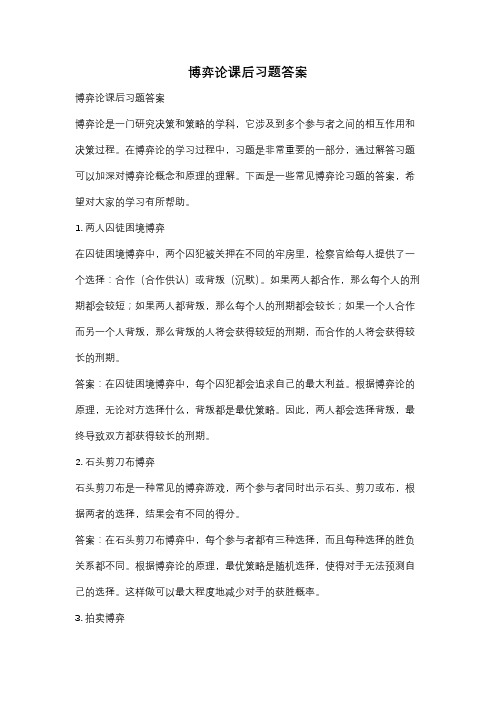
博弈论课后习题答案博弈论课后习题答案博弈论是一门研究决策和策略的学科,它涉及到多个参与者之间的相互作用和决策过程。
在博弈论的学习过程中,习题是非常重要的一部分,通过解答习题可以加深对博弈论概念和原理的理解。
下面是一些常见博弈论习题的答案,希望对大家的学习有所帮助。
1. 两人囚徒困境博弈在囚徒困境博弈中,两个囚犯被关押在不同的牢房里,检察官给每人提供了一个选择:合作(合作供认)或背叛(沉默)。
如果两人都合作,那么每个人的刑期都会较短;如果两人都背叛,那么每个人的刑期都会较长;如果一个人合作而另一个人背叛,那么背叛的人将会获得较短的刑期,而合作的人将会获得较长的刑期。
答案:在囚徒困境博弈中,每个囚犯都会追求自己的最大利益。
根据博弈论的原理,无论对方选择什么,背叛都是最优策略。
因此,两人都会选择背叛,最终导致双方都获得较长的刑期。
2. 石头剪刀布博弈石头剪刀布是一种常见的博弈游戏,两个参与者同时出示石头、剪刀或布,根据两者的选择,结果会有不同的得分。
答案:在石头剪刀布博弈中,每个参与者都有三种选择,而且每种选择的胜负关系都不同。
根据博弈论的原理,最优策略是随机选择,使得对手无法预测自己的选择。
这样做可以最大程度地减少对手的获胜概率。
3. 拍卖博弈拍卖是一种常见的博弈形式,参与者通过竞价来争夺一个物品或服务。
在拍卖中,不同的拍卖规则和策略会对结果产生影响。
答案:在拍卖博弈中,最常见的策略是以自己的估值为基准进行竞价。
如果一个参与者的估值高于其他参与者,那么他可以通过竞价来获得物品或服务。
然而,如果其他参与者也有较高的估值,那么竞价将会继续上升,直到只剩下一个竞价者。
在这种情况下,最高的竞价者将会获得物品或服务,但是他需要支付他的竞价。
4. 价格战博弈价格战是一种常见的博弈形式,不同的公司通过调整价格来争夺市场份额。
在价格战中,公司的利润和市场份额会受到价格策略的影响。
答案:在价格战博弈中,最优策略取决于对手的策略和市场需求。
博弈论 课后习题答案
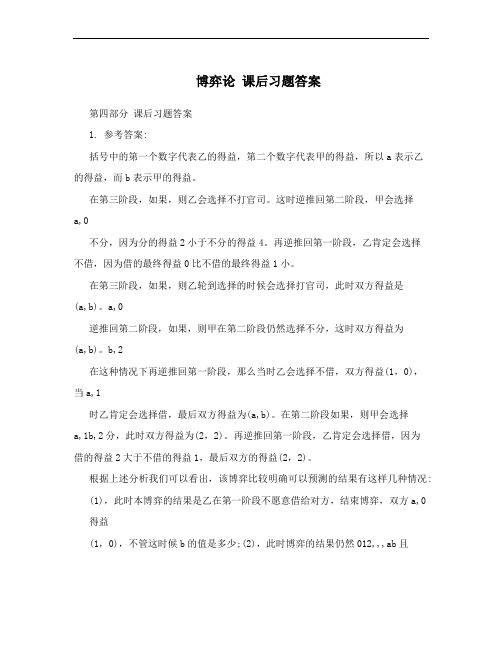
博弈论课后习题答案第四部分课后习题答案1. 参考答案:括号中的第一个数字代表乙的得益,第二个数字代表甲的得益,所以a表示乙的得益,而b表示甲的得益。
在第三阶段,如果,则乙会选择不打官司。
这时逆推回第二阶段,甲会选择a,0不分,因为分的得益2小于不分的得益4。
再逆推回第一阶段,乙肯定会选择不借,因为借的最终得益0比不借的最终得益1小。
在第三阶段,如果,则乙轮到选择的时候会选择打官司,此时双方得益是(a,b)。
a,0逆推回第二阶段,如果,则甲在第二阶段仍然选择不分,这时双方得益为(a,b)。
b,2在这种情况下再逆推回第一阶段,那么当时乙会选择不借,双方得益(1,0),当a,1时乙肯定会选择借,最后双方得益为(a,b)。
在第二阶段如果,则甲会选择a,1b,2分,此时双方得益为(2,2)。
再逆推回第一阶段,乙肯定会选择借,因为借的得益2大于不借的得益1,最后双方的得益(2,2)。
根据上述分析我们可以看出,该博弈比较明确可以预测的结果有这样几种情况:(1),此时本博弈的结果是乙在第一阶段不愿意借给对方,结束博弈,双方a,0得益(1,0),不管这时候b的值是多少;(2),此时博弈的结果仍然012,,,ab且是乙在第一阶段选择不借,结束博弈,双方得益(1,0);(3),此时博ab,,12且弈的结果是乙在第一阶段选择借,甲在第二阶段选择不分,乙在第三阶段选择打,最后结果是双方得益(a,b);(4),此时乙在第一阶段会选择借,甲在第二阶段会选择分,ab,,02且双方得益(2,2)。
要本博弈的“威胁”,即“打”是可信的,条件是。
要本博弈的“承诺”,即a,0“分”是可信的,条件是且。
a,0b,2注意上面的讨论中没有考虑a=0、a=1、b=2的几种情况,因为这些时候博弈方的选择很难用理论方法确定和预测。
不过最终的结果并不会超出上面给出的范围。
2. 参考答案:静态贝叶斯博弈中博弈方的一个策略是他们针对自己各种可能的类型如何作相应的完整计划。
博弈论基础作业及答案
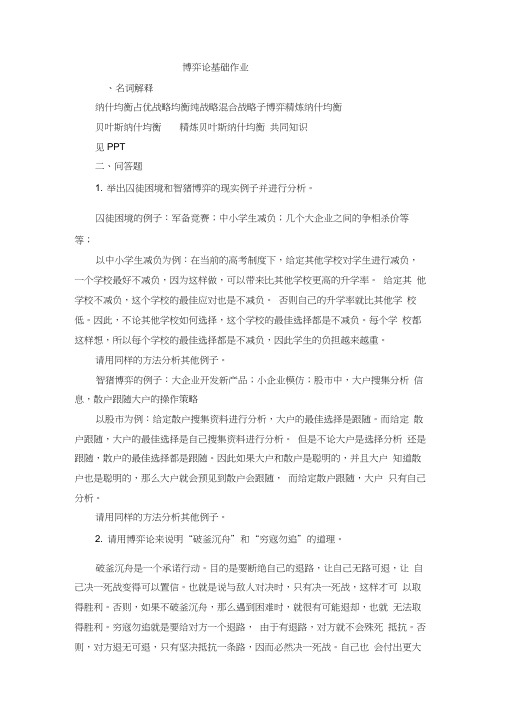
博弈论基础作业、名词解释纳什均衡占优战略均衡纯战略混合战略子博弈精炼纳什均衡贝叶斯纳什均衡精炼贝叶斯纳什均衡共同知识见PPT二、问答题1. 举出囚徒困境和智猪博弈的现实例子并进行分析。
囚徒困境的例子:军备竞赛;中小学生减负;几个大企业之间的争相杀价等等;以中小学生减负为例:在当前的高考制度下,给定其他学校对学生进行减负,一个学校最好不减负,因为这样做,可以带来比其他学校更高的升学率。
给定其他学校不减负,这个学校的最佳应对也是不减负。
否则自己的升学率就比其他学校低。
因此,不论其他学校如何选择,这个学校的最佳选择都是不减负。
每个学校都这样想,所以每个学校的最佳选择都是不减负,因此学生的负担越来越重。
请用同样的方法分析其他例子。
智猪博弈的例子:大企业开发新产品;小企业模仿;股市中,大户搜集分析信息,散户跟随大户的操作策略以股市为例:给定散户搜集资料进行分析,大户的最佳选择是跟随。
而给定散户跟随,大户的最佳选择是自己搜集资料进行分析。
但是不论大户是选择分析还是跟随,散户的最佳选择都是跟随。
因此如果大户和散户是聪明的,并且大户知道散户也是聪明的,那么大户就会预见到散户会跟随,而给定散户跟随,大户只有自己分析。
请用同样的方法分析其他例子。
2. 请用博弈论来说明“破釜沉舟”和“穷寇勿追”的道理。
破釜沉舟是一个承诺行动。
目的是要断绝自己的退路,让自己无路可退,让自己决一死战变得可以置信。
也就是说与敌人对决时,只有决一死战,这样才可以取得胜利。
否则,如果不破釜沉舟,那么遇到困难时,就很有可能退却,也就无法取得胜利。
穷寇勿追就是要给对方一个退路,由于有退路,对方就不会殊死抵抗。
否则,对方退无可退,只有坚决抵抗一条路,因而必然决一死战。
自己也会付出更大的代价。
3. 当求职者向企业声明自己能力强时, 企业未必相信。
但如果求职者拿出自 己的各种获奖证书时,却能在一定程度上传递自己能力强的信息。
这是为什么? 由于口头声明几乎没有成本,因此即便是能力差的求职者也会向企业声明自 己能力强。
博弈论基础作业及答案
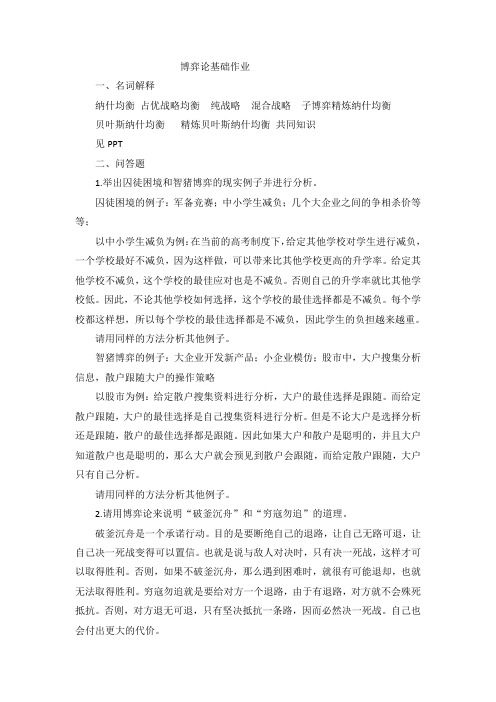
博弈论基础作业一、名词解释纳什均衡占优战略均衡纯战略混合战略子博弈精炼纳什均衡贝叶斯纳什均衡精炼贝叶斯纳什均衡共同知识见PPT二、问答题1.举出囚徒困境和智猪博弈的现实例子并进行分析。
囚徒困境的例子:军备竞赛;中小学生减负;几个大企业之间的争相杀价等等;以中小学生减负为例:在当前的高考制度下,给定其他学校对学生进行减负,一个学校最好不减负,因为这样做,可以带来比其他学校更高的升学率。
给定其他学校不减负,这个学校的最佳应对也是不减负。
否则自己的升学率就比其他学校低。
因此,不论其他学校如何选择,这个学校的最佳选择都是不减负。
每个学校都这样想,所以每个学校的最佳选择都是不减负,因此学生的负担越来越重。
请用同样的方法分析其他例子。
智猪博弈的例子:大企业开发新产品;小企业模仿;股市中,大户搜集分析信息,散户跟随大户的操作策略以股市为例:给定散户搜集资料进行分析,大户的最佳选择是跟随。
而给定散户跟随,大户的最佳选择是自己搜集资料进行分析。
但是不论大户是选择分析还是跟随,散户的最佳选择都是跟随。
因此如果大户和散户是聪明的,并且大户知道散户也是聪明的,那么大户就会预见到散户会跟随,而给定散户跟随,大户只有自己分析。
请用同样的方法分析其他例子。
2.请用博弈论来说明“破釜沉舟”和“穷寇勿追”的道理。
破釜沉舟是一个承诺行动。
目的是要断绝自己的退路,让自己无路可退,让自己决一死战变得可以置信。
也就是说与敌人对决时,只有决一死战,这样才可以取得胜利。
否则,如果不破釜沉舟,那么遇到困难时,就很有可能退却,也就无法取得胜利。
穷寇勿追就是要给对方一个退路,由于有退路,对方就不会殊死抵抗。
否则,对方退无可退,只有坚决抵抗一条路,因而必然决一死战。
自己也会付出更大的代价。
3.当求职者向企业声明自己能力强时,企业未必相信。
但如果求职者拿出自己的各种获奖证书时,却能在一定程度上传递自己能力强的信息。
这是为什么由于口头声明几乎没有成本,因此即便是能力差的求职者也会向企业声明自己能力强。
博弈论各章节课后习题答案 (2)
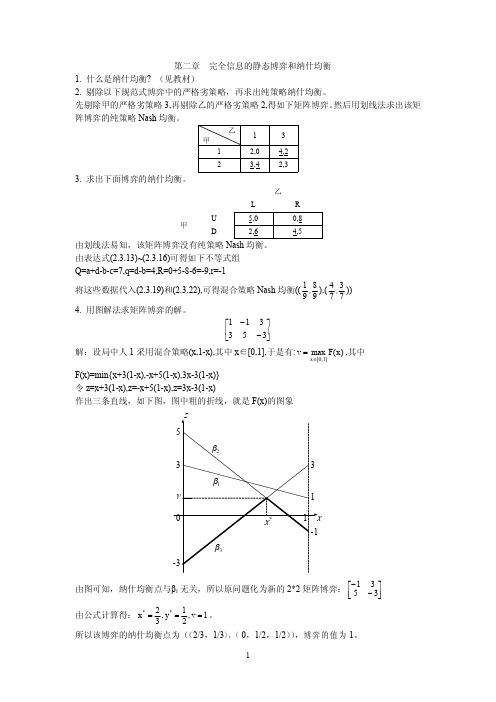
(1)
( q1*, q*2,⋯, q*n )组成该博弈的纯策略纳什均衡点。
2
∑ 式(1)两边同时求和,可得:
n
q*i
=
Q*
=
n(a
−
c
−
Q* )
,于是
Q*
=
n (a n +1
−
c)
,
i =1
q*
=
a
−c
−
Q*
=
a−c n +1
,此时
p*=a-Q*=
a + nc n +1
,当
n
趋于无群大时,有
Q*=a-c,
(aij + d)x*i y j 是成 立的 , 此即 为 XA2Y* ≤ X*A2Y* ≤ X*A2Y 。所以
i =1 j=1
i =1 j=1
(X*,Y*)是矩阵博弈 G2 的纳什均衡点,并且
mn
mn
∑ ∑ ∑ ∑ v(G2) =
(a ij
+
d)x
* i
y*j
=
aijx*i y*j + d = v(G1) + d
第二章 完全信息的静态博弈和纳什均衡
1. 什么是纳什均衡? (见教材)
2. 剔除以下规范式博弈中的严格劣策略,再求出纯策略纳什均衡。
先剔除甲的严格劣策略 3,再剔除乙的严格劣策略 2,得如下矩阵博弈。然后用划线法求出该矩
阵博弈的纯策略 Nash 均衡。
乙
甲
1
3
1
2,0 4,2
2
3,4 2,3
3. 求出下面博弈的纳什均衡。
该博弈的纳什均衡为下图的线段 AB:即:s1+s2=100,s1,s2∈[0,100]。
博弈论基础 习题2
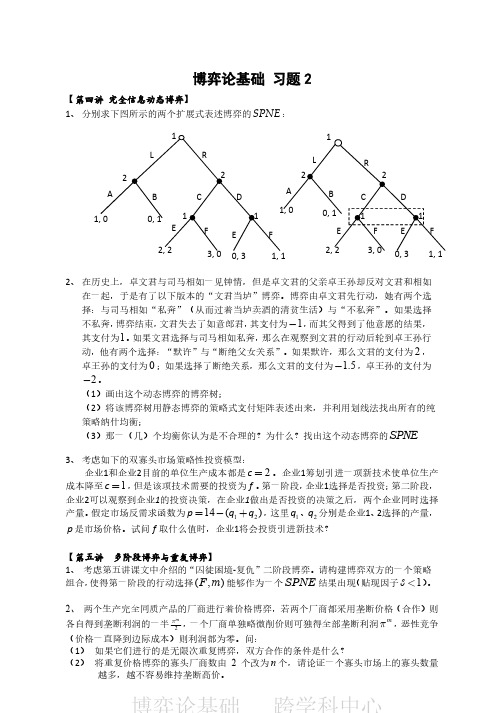
博弈论基础 习题2【第四讲 完全信息动态博弈】1、 分别求下图所示的两个扩展式表述博弈的SPNE :2、 在历史上,卓文君与司马相如一见钟情,但是卓文君的父亲卓王孙却反对文君和相如在一起,于是有了以下版本的“文君当垆”博弈。
博弈由卓文君先行动,她有两个选择:与司马相如“私奔”(从而过着当垆卖酒的清贫生活)与“不私奔”。
如果选择不私奔,博弈结束,文君失去了如意郎君,其支付为1 ,而其父得到了他意愿的结果,其支付为1。
如果文君选择与司马相如私奔,那么在观察到文君的行动后轮到卓王孙行动,他有两个选择:“默许”与“断绝父女关系”。
如果默许,那么文君的支付为2,卓王孙的支付为0;如果选择了断绝关系,那么文君的支付为 1.5 ,卓王孙的支付为2 。
(1)画出这个动态博弈的博弈树;(2)将该博弈树用静态博弈的策略式支付矩阵表述出来,并利用划线法找出所有的纯策略纳什均衡;(3)那一(几)个均衡你认为是不合理的?为什么?找出这个动态博弈的SPNE3、 考虑如下的双寡头市场策略性投资模型:企业1和企业2目前的单位生产成本都是2c 。
企业1筹划引进一项新技术使单位生产成本降至1c ,但是该项技术需要的投资为f 。
第一阶段,企业1选择是否投资;第二阶段,企业2可以观察到企业1的投资决策,在企业1做出是否投资的决策之后,两个企业同时选择产量。
假定市场反需求函数为1214()p q q ,这里1q 、2q 分别是企业1、2选择的产量,p 是市场价格。
试问f 取什么值时,企业1将会投资引进新技术?【第五讲 多阶段博弈与重复博弈】1、 考虑第五讲课文中介绍的“囚徒困境-复仇”二阶段博弈。
请构建博弈双方的一个策略组合,使得第一阶段的行动选择(,)F m 能够作为一个SPNE 结果出现(贴现因子1 )。
2、 两个生产完全同质产品的厂商进行着价格博弈,若两个厂商都采用垄断价格(合作)则各自得到垄断利润的一半2m,一个厂商单独略微削价则可独得全部垄断利润m,恶性竞争(价格一直降到边际成本)则利润都为零。
博弈论基础作业及答案

博弈论基础作业一、名词解释纳什均衡占优战略均衡纯战略混合战略子博弈精炼纳什均衡贝叶斯纳什均衡精炼贝叶斯纳什均衡共同知识见PPT二、问答题1.举出囚徒困境和智猪博弈的现实例子并进行分析。
囚徒困境的例子:军备竞赛;中小学生减负;几个大企业之间的争相杀价等等;以中小学生减负为例:在当前的高考制度下,给定其他学校对学生进行减负,一个学校最好不减负,因为这样做,可以带来比其他学校更高的升学率。
给定其他学校不减负,这个学校的最佳应对也是不减负。
否则自己的升学率就比其他学校低。
因此,不论其他学校如何选择,这个学校的最佳选择都是不减负。
每个学校都这样想,所以每个学校的最佳选择都是不减负,因此学生的负担越来越重。
请用同样的方法分析其他例子。
智猪博弈的例子:大企业开发新产品;小企业模仿;股市中,大户搜集分析信息,散户跟随大户的操作策略以股市为例:给定散户搜集资料进行分析,大户的最佳选择是跟随。
而给定散户跟随,大户的最佳选择是自己搜集资料进行分析。
但是不论大户是选择分析还是跟随,散户的最佳选择都是跟随。
因此如果大户和散户是聪明的,并且大户知道散户也是聪明的,那么大户就会预见到散户会跟随,而给定散户跟随,大户只有自己分析。
请用同样的方法分析其他例子。
2.请用博弈论来说明“破釜沉舟”和“穷寇勿追”的道理。
破釜沉舟是一个承诺行动。
目的是要断绝自己的退路,让自己无路可退,让自己决一死战变得可以置信。
也就是说与敌人对决时,只有决一死战,这样才可以取得胜利。
否则,如果不破釜沉舟,那么遇到困难时,就很有可能退却,也就无法取得胜利。
穷寇勿追就是要给对方一个退路,由于有退路,对方就不会殊死抵抗。
否则,对方退无可退,只有坚决抵抗一条路,因而必然决一死战。
自己也会付出更大的代价。
3.当求职者向企业声明自己能力强时,企业未必相信。
但如果求职者拿出自己的各种获奖证书时,却能在一定程度上传递自己能力强的信息。
这是为什么?由于口头声明几乎没有成本,因此即便是能力差的求职者也会向企业声明自己能力强。
吉本斯博弈论基础pdf

吉本斯博弈论基础pdf
吉本斯博弈论基础主要包括以下几个方面:
1.参与者:在博弈论中,参与者是决策的主体,可以是个人、组织或国家等。
在吉本斯博弈论中,参与者通常被视为具有有限理性的个体,他们根据自身的利益和偏好进行决策。
2.战略:战略是参与者在博弈中的选择,可以是合作或竞争等不同的行为方式。
在吉本斯博弈论中,战略的制定需要考虑对手的反应和预期,以达到最优的决策效果。
3.收益:收益是参与者在博弈中的结果,可以是经济利益、社会地位等。
在吉本斯博弈论中,收益的分配取决于参与者的策略选择和博弈规则的设定。
4.均衡:均衡是博弈中的一种状态,指所有参与者的最优策略组合。
在吉本斯博弈论中,均衡的概念非常重要,它是分析博弈结果和预测未来行为的基础。
5.动态博弈:动态博弈是指参与者的决策和行动有先后顺序,后行动者可以根据先行动者的行为做出最优的决策。
在吉本斯博弈论中,动态博弈的分析需要考虑时间因素和信息不完全等因素。
总的来说,吉本斯博弈论基础主要包括参与者、战略、收益、均衡和动态博弈等几个方面。
这些基础概念和分析方法构成了吉本斯博弈论的基本框架,为研究决策制定和行为模式提供了重要的理论支持。
博弈论和信息经济学答案解析
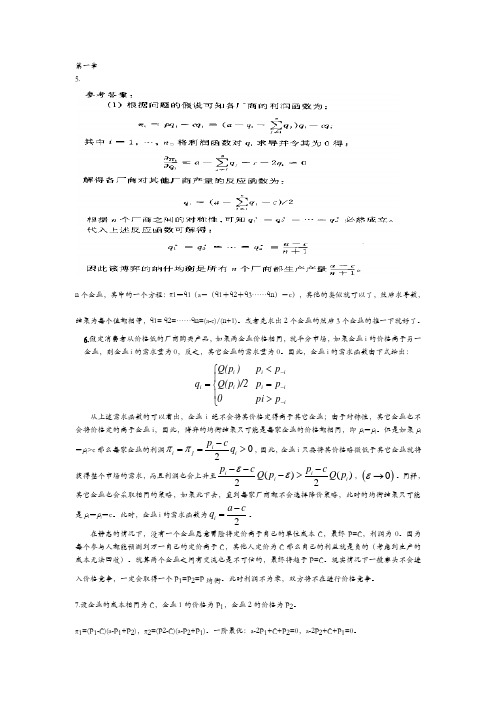
第一章 5.n 个企业,其中的一个方程:π1=q 1(a -(q 1+q 2+q 3……q n )-c ),其他的类似就可以了,然后求导数,结果为每个值都相等,q 1= q 2=……q n=(a-c)/(n+1)。
或者先求出2个企业的然后3个企业的推一下就好了。
6.假定消费者从价格低的厂商购买产品,如果两企业价格相同,就平分市场,如果企业i 的价格高于另一企业,则企业i 的需求量为0,反之,其它企业的需求量为0。
因此,企业i 的需求函数由下式给出:i ii i i i i i p pi p p p p 0)/2Q(p )Q(p q --->=<⎪⎩⎪⎨⎧=从上述需求函数的可以看出,企业i 绝不会将其价格定得高于其它企业;由于对称性,其它企业也不会将价格定的高于企业i ,因此,博弈的均衡结果只可能是每家企业的价格都相同,即p i =p j 。
但是如果p i=p j >c 那么每家企业的利润02i ij i p cq ππ-==>,因此,企业i 只要将其价格略微低于其它企业就将获得整个市场的需求,而且利润也会上升至()()22i i i i p c p cQ p Q p εε---->,()0ε→。
同样,其它企业也会采取相同的策略,如果此下去,直到每家厂商都不会选择降价策略,此时的均衡结果只可能是p i =p j =c 。
此时,企业i 的需求函数为2ia c q -=。
在静态的情况下,没有一个企业愿意冒险将定价高于自己的单位成本C ,最终P=C ,利润为0。
因为每个参与人都能预测到万一自己的定价高于C ,其他人定价为C 那么自己的利益就是负的(考虑到生产的成本无法回收)。
就算两个企业之间有交流也是不可信的,最终将趋于P=C 。
现实情况下一般寡头不会进入价格竞争,一定会取得一个P 1=P 2=P 均衡。
此时利润不为零,双方将不在进行价格竞争。
7.设企业的成本相同为C ,企业1的价格为P 1,企业2的价格为P 2。
3人对决

附录1:三人对决问题A 、B 、C 三人决斗,每人每次发射一枪。
A 枪法最差,命中概率为A P ;B 次之,命中概率B P ;C 是神枪手,命中概率为1。
显然1A B P P <<。
三位按照ABC 的顺序依次发射,直到只剩一人存活。
每个射手,在轮到其发射时,他可以选择任一对手开枪射击,也可以对空射击(不会射杀任何人)。
假设任一射手一旦中抢即毙命,死亡的射手不允许再射击。
问:A 的最佳策略是什么?分析:如果只剩下一个对手,那么最佳的选择就是向那个对手开枪;如果两个对手都存在,而轮到A 射击时,那么情况就与博弈开始时由A 射击的情况一样。
所以,只需要重点考虑A 刚开始博弈时会怎么选择。
A 刚开始博弈时面临的选择不外三种:对空发射、对C 发射、对B 发射。
此三种情况逐一分析。
n 是循环次数,也可理解为抢中最少子弹数。
脚标1、2、3表示我们讨论的三种情况。
脚标A 、B 是代表参与人。
C 未出现,因为Pc=1,直接以1代入就可以。
(一) 对空发射。
若A 对空发射,则A 获胜的可能的后续情况如下:(1) B 射中C ,A 射中B 。
(2) B 射中C ,“A 未射中B ,B 未射中A ”循环n 次(n ≥1),然后A 射中B 。
(3) B 为射中C ,C 射中B ,A 射中C 。
令1ˆP 表示采取对空发射的策略,那么A 获胜(存活)的概率为 []11ˆ(1)(1)(1)n A B B A B A B An P P P P P P P P P ∞==+--+-∑ (1)(1)1(1)(1)A B A B A A B P P P P P P P --=+--- 212121(1)(1).1(1)(1)A P P P P P ⎡⎤---⎣⎦=---(二)A 射向C此时,若A 未射中C ,则事态将如同策略(一)的发展;若A 射中C ,则事态发展为:B 未射中A ,“A 未射中B ,B 未射中A ”循环n 次(0n ≥),然后A 射中B 。
博弈论各章节课后习题答案

9. 求如图所示完全信息动态博弈的子博弈完美纳什均衡(图中数字(a,b,c)分别表示局中人 1、
2、3 的 收 益 )。
1
A1
A2
3
2
C1
C2
B1
B2
(4,2,3)
(1,7,8) 3
C1
C2 C1
3
C2
(5,4,3) (7,6,6) (2,1,9) (0,4,2)
答:局中人 1 采取 A2 行 动 ,局中人 2 采取行动 B1 时,局中人 3 必然采取 C2 行 动( 因为 3<6), 因而该博弈的顶点只能是(7,6,6)。同样对于局中人 3 右边一个子博弈,必然采取 C1 行动 (9>2),因而该博弈的顶点只能是(2,1,9)。进而原博弈简化为:
的定价,qi是企业i的需求量。假设企业生产没有固定成本,并且边际成本为常数c,c<a.假定博弃 重复无穷多次,每次的价格都立即被观察到,企业使用触发策略。求使垄断价格可以作为完美 均衡结果出现的最低贴现因子δ,并解释δ与n的关系。
分以下几个步骤进行。
1)计算纳什均衡 当企业 i 选择价格 pi,其它企业选择价格 pj(j=1,2,…,n,j≠i)时,企业 i 的利润为: πi = (pi − c)qi = (pi − c)(a − pi + b(p1 + p2 + ⋯ + pi−1 + pi+1 + ⋯ + pn )) ,i=1,2,…,n
∂π2 ∂q 2
= a − q1
− 2q2
− q3
−c=0
∂π3 ∂q3
=
a
− q1
− q2
− 2q3
−c
博弈论与信息基础复习资料
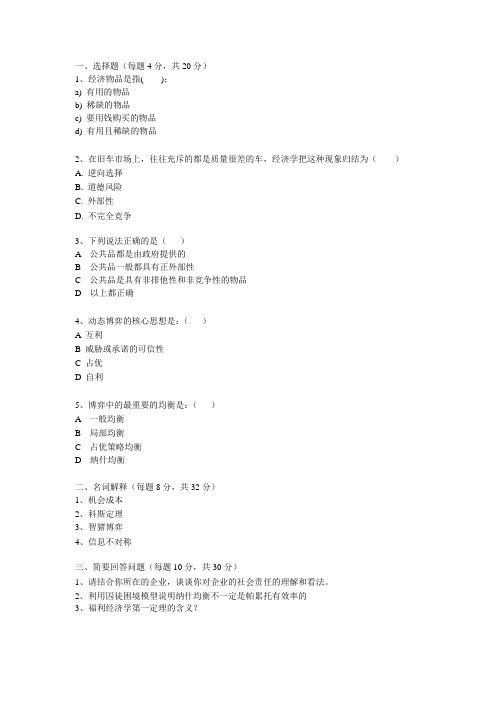
一、选择题(每题4分,共20分)
1、经济物品是指( );
a) 有用的物品
b) 稀缺的物品
c) 要用钱购买的物品
d) 有用且稀缺的物品
2、在旧车市场上,往往充斥的都是质量很差的车,经济学把这种现象归结为()
A. 逆向选择
B. 道德风险
C. 外部性
D. 不完全竞争
3、下列说法正确的是()
A 公共品都是由政府提供的
B 公共品一般都具有正外部性
C 公共品是具有非排他性和非竞争性的物品
D 以上都正确
4、动态博弈的核心思想是:()
A 互利
B 威胁或承诺的可信性
C 占优
D 自利
5、博弈中的最重要的均衡是:()
A 一般均衡
B 局部均衡
C 占优策略均衡
D 纳什均衡
二、名词解释(每题8分,共32分)
1、机会成本
2、科斯定理
3、智猪博弈
4、信息不对称
三、简要回答问题(每题10分,共30分)
1、请结合你所在的企业,谈谈你对企业的社会责任的理解和看法。
2、利用囚徒困境模型说明纳什均衡不一定是帕累托有效率的
3、福利经济学第一定理的含义?
四、论述题(18分)
我们经常在报纸上看到很多企业(比如家电企业)经常希望建立价格联盟,但往往是无功而返。
即使价格联盟成立了,也很快就破裂了。
请用囚徒困境的思想进行解释。
吉本斯《博弈论基础》课后习题答案
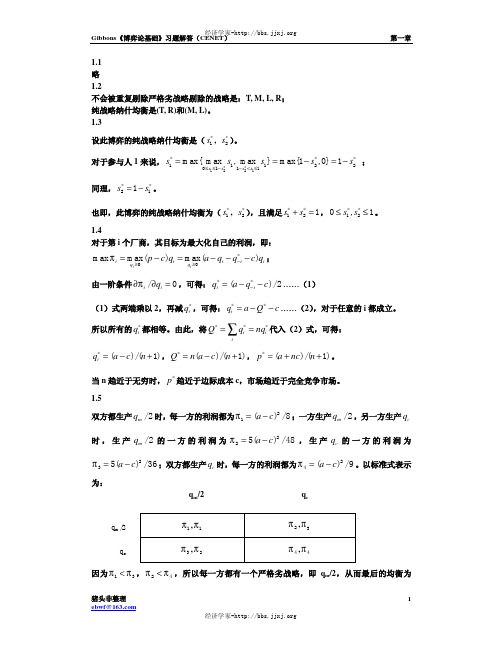
对 于 2 来 说 , 4(1− p*) = 2 p* + 3(1− p*) , 得 p* = 1/ 3 。
则 原 博 弈 的 混 合 战 略 纳 什 均 衡 为 : { (1/3, 2/3, 0), (2/3, 0, 1/3) }。 1.12 按 照 1.11 的 解 法 , 可 得 混 合 战 略 纳 什 均 衡 为 : { (2/3, 1/3), (3/4, 1/4) }。 过 程 略 。 1.13 此博弈有两个纯战略纳什均衡、一个混合战略纳什均衡。 纯 战 略 纳 什 均 衡 为 :( 向 企 业 1 申 请 , 向 企 业 2 申 请 );( 向 企 业 2 申 请 , 向 企 业 1 申 请 )。 混合战略纳什均衡为:
为:
qm/2
qc
qm/2
π1 , π1
π2 ,π3
qc
π3 ,π2
π4 ,π4
因 为 π1 < π3 , π 2 < π 4 , 所 以 每 一 方 都 有 一 个 严 格 劣 战 略 , 即 qm/2, 从 而 最 后 的 均 衡 为
- 1、下载文档前请自行甄别文档内容的完整性,平台不提供额外的编辑、内容补充、找答案等附加服务。
- 2、"仅部分预览"的文档,不可在线预览部分如存在完整性等问题,可反馈申请退款(可完整预览的文档不适用该条件!)。
- 3、如文档侵犯您的权益,请联系客服反馈,我们会尽快为您处理(人工客服工作时间:9:00-18:30)。
+
B)i V
′′(I
p
V ′′(I p − B)
−
B)
+
kU
′′
2
(S
*
+
B)
+
U
′
2
(S
*
+
B)i V
′′(I
p
kU
′′
2
(S
*
+
B)
−
B
)
+
kU
′′
2
(
S
*
+
B)
hda =
U
′
2
(S
*
+
B)i V
′′(I
p
kU
′′
2
(S
*
+
B)
−
B)
+
kU
′′
2
(
S
*
+
B)
.k > 0 = f (S′)
www So S* < S′ . If child save more, i.e. S′ , both the parent’s and child’s payoffs could be
)2
+
(1 −
π
)
1 i( 2
aL − 2
c
)2
)
.
22
1−δ
In
period
with
demand aH , payoff from deviating is
(aH − c)2 ; 2
in period with
demand
aL , payoff from deviating is
( aL − c )2 . 2
(S
*
+
B)
=
0
On the other hand, if child chooses S′ to maximize U1(Ic − S) +U2 (S + B) ,
where B is exogenous, then S′ satisfies:
−U1′ ( I c
−
S ′)
+
U
′
2
(
S
′
+
B)
=
0
( A)
+
B)i(
I
′
c
(
A)
+
kU
−kU ′′(Ic + B) ′′(Ic + B) +V ′′(I p
−
B
)
i
I
′
c
(
A)
+
kU
V ′′(I p − B) ′′(Ic + B) +V ′′(I
p
−
iI B)
′
p
(
A))
=
U
′(Ic
(
A)
+
B)i kU
V ′′(I p − B) ′′(Ic + B) +V ′′(I
)
=
0
Because U is increasing and strictly concave, so
U
′(
I
c
(
A)
+
B)
>
0
⇒
(
Ic′
(
A)
+
∂B ∂A
)
=
0
(1)
(*)
对 A 求偏导:
kU
′′(Ic
(
A)
+
B)(Ic′
(
A)
+
∂B ∂A
)
−V
′′(I
p
(
A)
−
B)(I
′
p
(
A)
−
∂B ∂A
)
=
k increases, the total output increases, so does the demand for labor, so the union’ utility
. increases.
www 2.13 Proof: The monopoly price is p = a + c .
If V < (R − c1)2, c2 = 0 , both receive 0.
In Period one: partner 1 choose c1 . Consider four cases: (1) if R ≤ (1− δ )V , that is V − R2 ≥ δV , c1 = R , partner 1 will complete the
p
−
B)
i(
I
′
c
(
A)
+
I
′
p
(
A))
=
0
⇒
Ic′
(
A)
+
I
′
p
(
A)
=
0(
Since U ′(i) > 0, V ′′(i) < 0 and U ′′(i) < 0)
Another approach: Solving the game by backward induction:
At stage 2, given Ic and I p , parent chooses B to maximize his payoff:
2
If the firms use trigger strategies, then if there is no firm deviate, both get
案网 1i(a − c)2
on every stage game, and the total discounted profit is
1i( a − c)2 22 .
increased.
网 2.4 Solving the game by backward induction: 案 In Period two: given c1 , partner 2 choose c2 , the minimize of c2 to complete 后答 the project is R − c1 . 课 If V ≥ (R − c1)2, c2 = R − c1 , both receive V.
aH − 2
c
)2
+
(1 −
π
)
1 i( 2
aL − 2
c )2
)
≥
( aL
−
c
)2
22
1−δ
2
.c 1i(aH − c)2
aw ⇒ δ
≥
(π i1i( aH
− c)2
2 + (1− π )
2 1i( aL
− c)2) +
1i( aH
− c)2
d 2 2
22
22
h The lowest of δ such that the firms can use trigger strategies to sustain these
I
′
c
(
A)
+
∂B ∂A
)
=
0
h From (*), we have:
.k ∂B w ∂A
=
∂B ∂Ic
i
I
′
c
(
A)
+
∂B ∂I p
iI
′
p
(
A)
ww =
−
kU
kU ′′(Ic + ′′(Ic + B) +V
B) ′′(I
p
−
B)
i
I
′
c
(
A)
−
kU
−V ′′(Ic +
′′(I p − B) +V
课 1−δ
2
2
2.14
The monopoly price is
pH
=
aH + c , 2
pL
=
aL + c 2
If the firms use trigger strategies, and there is no firm deviate, in period with
demand aH , the total payoff is
ww max w B
V
(I
p
−
B)
+
k (U1 ( I c
−
S)
+
U2
(S
+
B))
FOC:
−V
′(I
p
−
B)
+
kU
′
2
(
S
+
B)
=
0
(*)
网 At stage 1, child maximizes his payoff:
案 max S
U1
(
Ic
−
S
)
+U2
(S
+
B)
答 FOC:
−U1′
(Ic
−
S
)
+
B) ′′(I
p
−
iI B)
′
p
(
A)
案网 =
−
kU
kU ′′(Ic + ′′(Ic + B) +V
